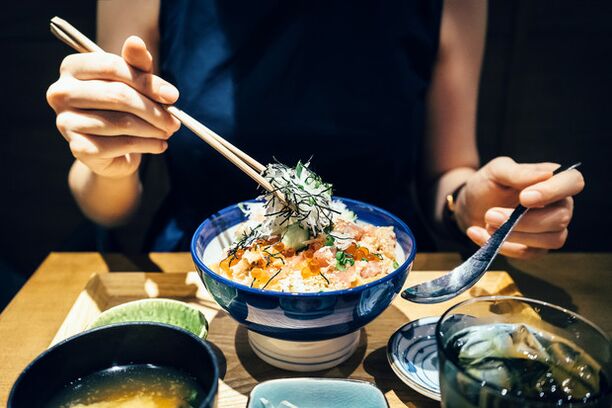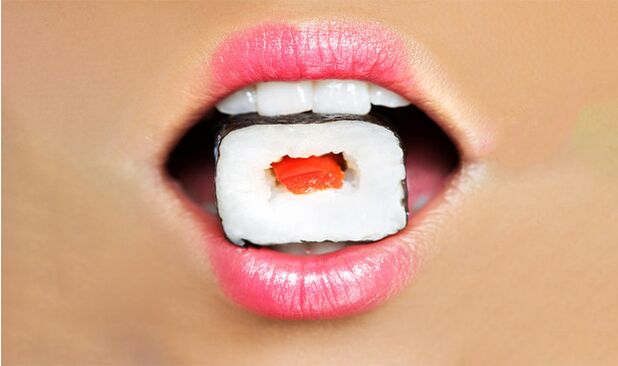The Japanese are famous for the harmonious physicist and a long life expectancy in many ways, this is due to the diet they follow.The editors turned to the medical science candidate, a sports medicine and sports dietary doctor, a specialized diet of the federal network of fitness clubs to discover all the characteristics of the diet.
The essence of the Japanese diet is the launch of metabolism.You need to clearly adhere to the menu, without changing the sequence of days or a set of products, clearly observing the kitchen rules.This diet can be called BESSOLEV precisely because you drink a lot and do not consume salty foods, kilograms are literally washed.

The diet is based on an increase in protein in the diet and limiting fat and carbohydrates.The base of your menu should be fish, chicken, meat, eggs, cheese and kefir with a low percentage of fat content.Vegetables are not prohibited in moderate amounts of fruits.The list of what you should refuse is much broader, as in any diet.
Forget salt, sugar, spices (they make you eat more than you need to satisfy hunger), leave smoked meats, bread, bananas and grapes in the store.
The Japanese woman, as this diet was affectionately called, threatens dehydration, so it is especially important for these 14 days to drink at least 2 liters of water a day.
You should not remain hungry at the expense of protein - satura well, the allowed cheese will give the minimum fat needed to the body and the vegetables - fibers and carbohydrates.
The Japanese diet menu is designed for a week after which it is planned to repeat the days past.During the diet, snacks and any deviations from the proposed menu are strictly prohibited, otherwise the result will be far from expected.
What they promise
Japanese diet duration: 7 to 14 days.No more!
How much can you throw away: Up to 8 kg.
Peculiarities: Available.
Cons of the Japanese diet:A very strict diet, it is difficult to endure and not break.
Some experts argue that the Japanese diet improves metabolism for up to two years, ie tormented for two weeks, and the result will be performed for a long time.
Characteristics of the nutrition of residents of Japan
Japan is a long -long country.The average life expectancy of women is 87 years old, and this is more than in any other country in the world.What is the reason for such an amazing life expectancy?Researchers believe that reason is in the lifestyle in general and in the culture of nutrition in particular.

First, the food in Japan is cooked, cooked and cooked in steam, but is not fried using a large amount of oil.This radically distinguishes the Japanese cuisine of the West and even Chinese, in which all the dishes are very fat.
Secondly, in the Japanese diet, there is an abundance of fresh seasonal products in combination with products of various colors.The principle of diversity, therefore, forms the basis of a healthy nutrition of the Japanese.
Third, the size of the Japanese part is small and in this they are radically different from the inhabitants of the countries of other states.Desserts in Japan are much smaller than the traditional western, and huge portions, to which the inhabitants of some countries are used to (for example, 400 grams of pork kebabs) are completely unacceptable to the Japanese.
Japanese underwater diet stones
"The problem is that the Japanese diet has nothing to do with the type of Japanese nutrition," comments an addition to the legend of a specialist Diet, the diet was developed in a certain Japanese clinic.However, there is no description of this clinic or its address on any website in English or Russian.At the same time, typing a phrase with the name of this clinic in any research mechanism, you can find over a thousand monotonous texts with a description of the Japanese diet.However, trusting my medical experience, I can confidence that the Japanese diet does not exist.I will give the justification of my position.
- The Japanese diet is a low calorie diet designed for 7 to 14 days.During this time you can really throw a few pounds because any strict restriction on food leads to weight loss.However, adipose tissue is not only an extra substance, but the most important endocrine organ.A marked release of several pounds is full of an imbalance of hormonal regulation of metabolism.
- This is a low carbohydrate diet.However, carbohydrates, along with proteins and fats, are an important component of nutrition.In addition, carbohydrates are a source of energy we use daily for mental and physical work.An alternative source of fat in the form of fat in the Japanese diet is not contained.
- This is a diet that essentially does not provide breakfast because it is difficult to call black coffee or vegetable breakfast.However, breakfast is the main meal, thanks to which we get all the necessary components of nutrition (proteins, fats and carbohydrates) for proper functioning in the first half of the day.
- This is finally a diet.Any restriction -based diet does not take into account the rules of eating behavior and healthy diet.Subsequently, this leads to the fact that the classic mechanism "lost weight in a diet is released - improved after the diet."
Therefore, it is no different from other diets that do not have a dignified justification: they are united by slogans that guarantee a rapid loss of 10 kg per week and, at the same time, do not take into account the consequences of strong weight loss for human health.
Anyway, preparations for the diet should be complete, it is better to consult your doctor before going to Japanese food.You can experience a diet this way if you don't have it against -indications: pregnant women, breastfeeding mothers, with liver disease, kidneys, gastritis and ulcer should not move to such a difficult diet.

Japanese diet during the day
The first day
Breakfast: Black coffee (always without sugar and milk).
To have lunch: 2 hard boiled eggs, boiled cabbage salad (vegetable salads are seasoned with vegetable oil) and a glass of tomato juice.
To have lunch: 250 g of cooked or fried fish.
The second day
- Breakfast: Black coffee and a piece of rye bread.
- To have lunch: 250 g of cooked or fried fish, cooked cabbage salad.
- To have lunch:100 g of cooked meat and a glass of kefir.
The third day
- Breakfast: Black coffee and a piece of rye bread.
- To have lunch: Large fried zucchini in vegetable oil.
- To have lunch: 2 hard boiled eggs, 200 g of saltless cooked meat, raw cabbage salad.
The fourth day
- Breakfast: Black coffee.
- To have lunch: 1 egg, 3 carrots and 15 g of cheese.
- To have lunch: 200 g of fruits.
Fifth day
- Breakfast: Grated carrots with lemon juice.
- To have lunch: 200 g of cooked or fried fish and a glass of tomato juice.
- To have lunch: 200 g of any fruit.
Sixth day
- Breakfast: Black coffee.
- To have lunch: 400 g of saltless cooked chicken, a fresh cabbage salad and carrots.
- To have lunch: 2 eggs are screwed and fresh carrots.
Seventh day
- Breakfast: tea.
- To have lunch: 200 g of unsalted cooked meat, 200 g of fruits.
- Any of the previous dinners.
There are many against -indications in this diet, from stomach diseases to adolescence or pregnancy, so before its use is a medical consultation.
Eighth day
- Breakfast:Black coffee.
- To have lunch:500 g of frustrated chicken and a carrot and cabbage salad.
- To have lunch: Fresh carrots and 2 boiled eggs.
Ninth day
- Breakfast: Grated carrots with lemon juice.
- To have lunch: 200 g of cooked or fried fish and a glass of tomato juice.
- To have lunch: 200 g of fruits (you can make a salad).
Tenth day
- Breakfast: Black coffee.
- To have lunch: 3 boiled carrots, 1 boiled egg and 50 g of cheese.
- To have lunch: 200 g of fruits.
The eleventh day
- Breakfast: Black coffee and a piece of rye bread.
- To have lunch: Large fried zucchini in vegetable oil.
- To have lunch:200 g of cooked beef, 2 boiled eggs and fresh cabbage salad.
Twelfth day
- Breakfast: Black coffee and a piece of rye bread.
- To have lunch: 200 g of cooked or fried fish with fresh cabbage salad.
- To have lunch: 100 g of unsalted cooked meat and a glass of kefir.
The thirteenth day
- Breakfast: Black coffee.
- To have lunch: 2 boiled eggs, cooked cabbage and a glass of tomato juice.
- To have lunch: 200 g of cooked or fried fish.
Fourteenth day
- Breakfast: Black coffee.
- To have lunch: 200 g of cooked or fried fish, fresh cabbage salad.
- To have lunch: 200 g of cooked meat, a glass of kefir.































